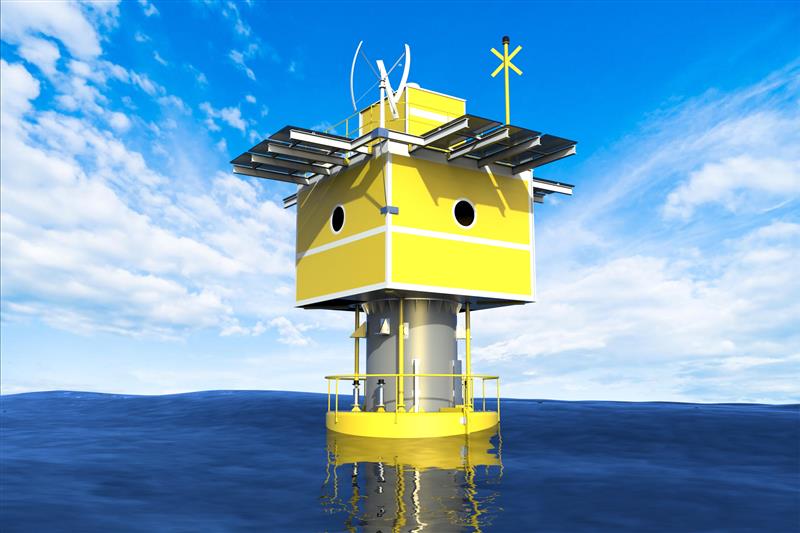
The siting of offshore wind energy projects is critical: tough to undo once it is done. For this reason the development of offshore wind farms has to be planned without compromising the ecosystem and the carrying capacity of the marine areas - meeting the requirements of the EU Nature Directives, the Marine Strategy Framework Directive and the Maritime Spatial Planning Directive (article 5-1 and 5-2). The future of sustainable offshore developments will be highly driven by environmental regulations and data collection. Therefore, such projects require large amounts of accurate environmental data, such as abundant longitudinal data that is typically collected over long periods, often through outdated methods.
The FLORA project partners are developing an industrial-scale prototype of an ocean station with renewable energy generation and oceanographic capabilities: the FLORA Ocean Station (or FLORA O.S.). Equipped with a novel sensor suite, the FLORA O.S. will gather data on bird and biodiversity, which is critical to Marine Spatial Planning (MSP), with low environmental impact. As an automated data acquisition tool, the FLORA O.S. will accelerate ocean space multi-use by eliminating much of random sampling, estimation and extrapolation in which modern Environmental Impact Assessments are largely rooted. The European Commission's 2020 Guide on Wind Energy Developments and EU Nature legislation urges that the assessment of the plan or project is based on good quality, objective information and reliable data, using appropriate and robust, scientific methodology.
An award-winning design
In April 2024, the FLORA design has received the iF DESIGN Award 2024 in the "Product / Industry" category, which is the most prestigious design award. With 10,800 entries from 72 countries, the iF DESIGN Award proved to be one of the most prestigious and relevant design competitions in the world. This award highlighted the creativity and industrial expertise that went into creating the FLORA ocean station design.
The station’s power will be generated through its 21 KW, hybridised (wave and solar PV) system, thus making the station more reliable as a remote oceanic sensor in high latitude marine environments. Based on Wedge’s 2014 wave energy converter (decommissioned in 2021), the new FLORA industrial-scale prototype will display environmental sensors that enable remote operational oceanography. What’s more, the prototype is a ‘radar-enabled' device to collect long-term seabird data sets for the environmental impact assessments and consenting of proposed offshore wind arrays. The use of radar-sensed, spatial seabird data at an early stage can catalyse marine co-location of economic activity, through MSP, and mitigate the negative impacts on seabirds as well as promote suitable areas for offshore wind development.
According to the OceanSET 2021 annual report “an urgent need still remains to reduce the time necessary for permitting and consenting in order to develop a competitive ocean energy industry in Europe”. Facing this challenge, the automated bird & climate data services made possible by the FLORA O.S. will help unlock the roll-out of offshore renewables. On a broader conservation level, the source system will help mainstream so-called important bird and biodiversity areas (IBAs) into the renewable ocean energy sector. To date, the coordinator has entered into MOUs with an Offshore Wind developer for the feasibility of a commercial demonstration in the North Sea.
Funded under EMFAF, this 2-year project is being realised by project coordinator Wedge (Spain), where Composite Solutions (Portugal) will construct the base structure and Daretech (Irland) will develop a smart battery electric storage system. Elittoral (Spain) will design the environmental sensing programme and also advise the project as an end-user, ensuring that the project includes the ‘voice of the customer’. Laminak (France) will lead the go-to-market study as well as dissemination and communication. The detailed engineering will be finalised in December 2022 and 6 months later the demonstration will commence in the Canary Islands, where Wedge is based.
Please visit FLORA's website here.
- Reference
- EMFAF-2021-PIA-FLAGSHIP-101077554
- Project duration
- 1 Jun 2022 - 31 Jan 2025
- Project locations
- SpainPortugalIrelandFrance
- Overall budget
- €1 414 540
- EU contribution
- €990 18070% of the overall budget
- Project website
- FLORA
Stakeholders
Coordinators
Wedge Global (Spain)
- Website
- https://wedgeglobal.com/
Participants
Composite Solutions (Portugal)
Daretech (Ireland)
- Website
- https://www.daretech.ie/
Elittoral (Spain)
- Website
- https://www.elittoral.es/
